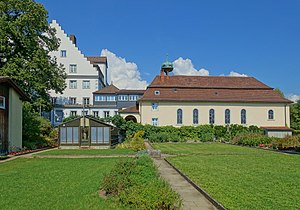Gurtweil Castle
| Gurtweil Castle | ||
|---|---|---|
|
South view of Gurtweiler Castle |
||
| Creation time : | 9th century | |
| Conservation status: | Successor building received | |
| Standing position : | Gaugrafen-Albgau | |
| Place: | Gurtweil | |
| Geographical location | 47 ° 38 '30 " N , 8 ° 14' 46" E | |
| Height: | 372 m above sea level NN | |
|
|
||
The Castle Gurtweil located in Schlüchttal in the village Gurtweil , a district of the district town Waldshut-Tiengen in the Baden-Wuerttemberg Waldshut .
Provost office of the St. Blasien Monastery
The palace building already had some previous buildings. Originally a Franconian estate, the property developed into a moated castle, which was destroyed by flames on May 13, 1660. Today's castle is a simple box structure that defines the townscape, extends over three floors and has stepped gables at the ends . The foundation stone was laid in 1662 and served as a residence for abbots and friars at the St. Blasien Monastery.
From 1720–1747 renovations and additions were carried out, such as an orangery (today's "St. Josef" chapel), orchards and flower gardens and a large barn. The interior was very splendid, and the beautiful Renaissance tiled stove was probably built at this time . Stucco work is also preserved, it comes from Franz Joseph Vogel .
In 1697 Martin Steinegg was appointed the first provost. From 1732 to 1749, Father Stanislaus Wülberz was provost in Gurtweil. The provosts and fathers Trudpert Neugart , Franz Kreutter , Ignatius Gumpp , Joseph Lukas Meyer and Columban Reble also lived there.
Napoleonic Wars
1807 was provost canceled Gurtweil. The castle was sold and served u. a. also as a hospital for Austrian soldiers suffering from typhoid fever. There is a memorial for those who died there on the curtain wall. At first it was a group of 250 sick soldiers from Prince Colloredo-Mansfeld's regiment. But when it became known that a military hospital had been set up in the provost's office, sick soldiers from far away were brought there. It was mainly Austrian soldiers who died of typhus . According to records by Joseph Lukas Meyer , it is said to have been around 3,000 between 1813 and 1814. In the village of Gurtweil, 250 people fell ill with typhus (well over half of the population), from January 15 to April 21, 1814 alone, 27 people from the village died.
Place of educational activity
In 1822, the Baden state sold the castle to Longin Gantert, whose son owned it until 1846. In 1857, on the initiative of pastor Hermann Keßler, it was bought with the help of donors and became the "rescue facility for endangered and neglected girls" as the monastery of Mariae vom Siege.
On December 3, 1857 pastor could Sisters of Ottmarsheim from 1845 under the Reverend Karl Rolfus formed joint Sisters of the Precious Blood of our Savior in the Holy. Sacrament in reparation and adoration in Steinerberg win Gurtweil. This community went back to the request of Gaspare del Bufalo and to the foundation by Maria de Mattias .
In 1867 a housekeeping school was added. When it became apparent from 1869 that the monastery would be closed, a new foundation was planned in America, and in 1873 49 sisters left their homeland. A total of five branches were then founded worldwide, for example in Ruma (Illinois), Banjaluka , Gutenberg and Schaan in Liechtenstein, Wichita , and in O'Fallon. Some sisters nevertheless stayed on site and continued their work without religious dress until 1894.
On May 1st, 1897, the "Riegel-Gurtweil Poor Children's Home" was opened by the church authorities. On behalf of the Archbishop's Ordinariate, Franciscan Sisters of the Divine Heart of Jesus from Gengenbach have since performed their service in Gurtweiler Castle.
Another turning point took place in 1980. The youth welfare facility closes. At the same time, the Caritas assistance for the handicapped is established in the castle and offers two residential groups with mentally handicapped men and women a home. To this day, the castle is part of the communal living "St. Elisabeth" run by the Caritaswerkstätten Hochrhein non-profit GmbH .
Castle chapel
The castle chapel (Marienkapelle) was consecrated on July 23, 1664 in honor of the Immaculate Conception of Mary by Auxiliary Bishop Sigismund von Konstanz . The chapel combines elements of the Renaissance and Baroque styles. White pilasters and baroque-shaped windows structure the outer walls. The elaborate furnishings of the high altar made in the auricle style is attributed to the well-known Waldshut altar maker Johann Christoph Feinlein . In the front floor area, there is a grave slab of the former superior of the girls' home, Augusta Volk († 1893). In the historic chapel, the founder of the order, Johann Baptist Jordan , Gurtweiler founder of the Salvatorian Order, which is widespread worldwide, was able to celebrate his post-primacy behind closed doors in 1878 as a barred new priest.
literature
- Franz Xaver Kraus (ed.): The art monuments of the Waldshut district . Mohr, Freiburg im Breisgau 1892 ( The art monuments of the Grand Duchy of Baden . Volume 3), pp. 125–126 ( online ).
- Leo Beringer: History of the village of Gurtweil , 1960
Web links
Individual evidence
- ^ Leo Beringer, Geschichte des Dorfes Gurtweil, pp. 222/223
- ^ Website of St. Elisabeth Schaan Monastery
- ^ Website of the Sisters of the Precious Blood in O'Fallo
- ^ Development of the Caritaswerkstätten Hochrhein non-profit GmbH. Retrieved May 19, 2019 .
- ^ Leo Beringer, Geschichte des Dorfes Gurtweil , 1960, p. 53




